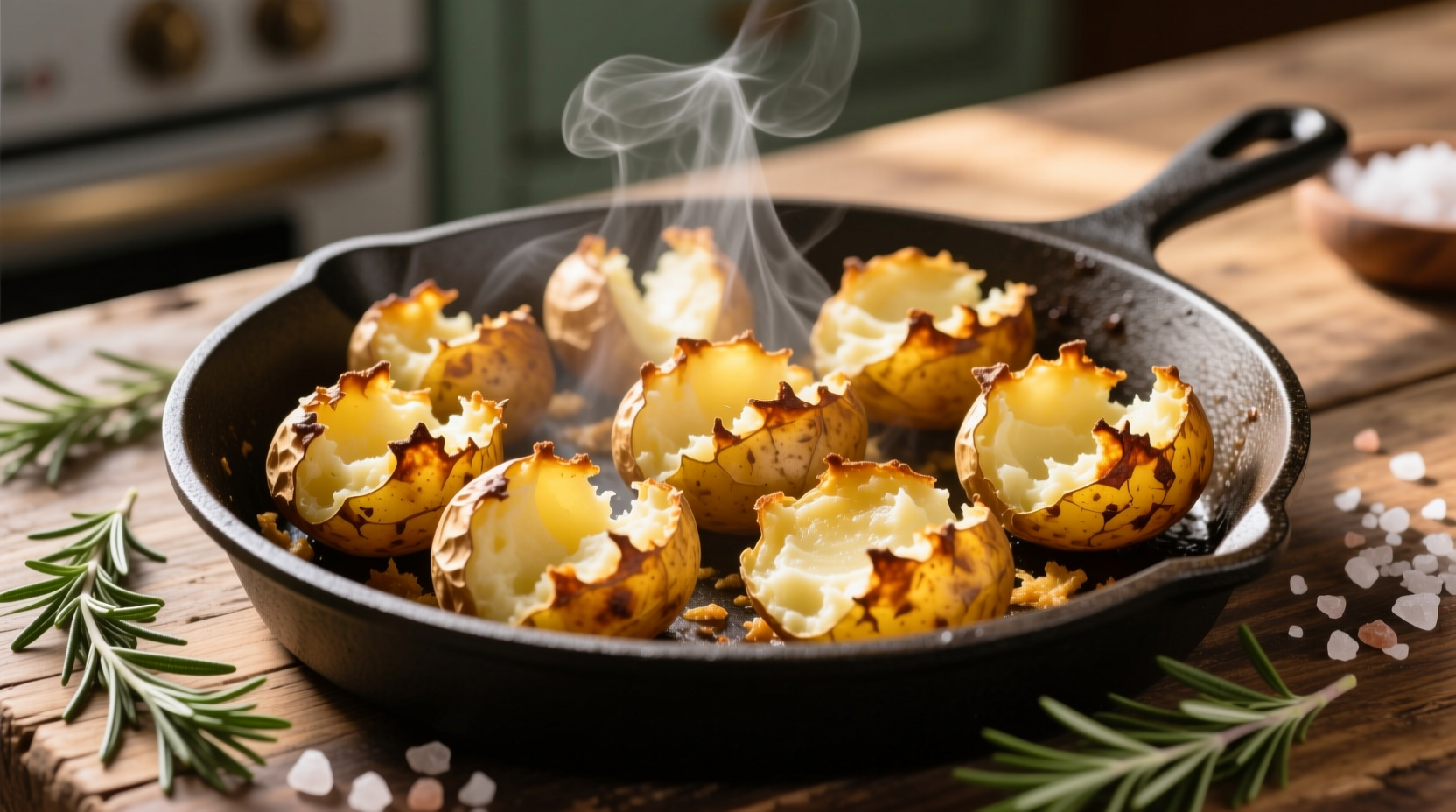The Science Behind Crispy Smashed Potatoes
Understanding the chemistry transforms your smashed potato salad from soggy disappointment to textural triumph. When potatoes reach 140°F (60°C), their starch granules swell and absorb water - a process called gelatinization. Parboiling to just fork-tender (15-18 minutes for 1¼" cubes) creates the ideal moisture balance. Too little boiling leaves ungelatinized starch that resists crisping; overcooking creates excess surface moisture that steams rather than crisps during roasting.
| Potato Variety | Starch Content | Moisture Level | Crispiness Rating |
|---|---|---|---|
| Yukon Gold | Medium (15-18%) | Medium | ⭐⭐⭐⭐⭐ |
| Red Bliss | Waxy (12-14%) | High | ⭐⭐⭐⭐☆ |
| Russet | High (20-22%) | Low | ⭐⭐⭐☆☆ |
| Fingerling | Waxy (13-15%) | Medium | ⭐⭐⭐⭐☆ |
Data sourced from the USDA Agricultural Research Service shows Yukon Gold's balanced starch-to-moisture ratio creates the ideal structural integrity for smashing while providing sufficient surface starch for browning. Waxy potatoes maintain shape better but require extended roasting time, while high-starch Russets often disintegrate during smashing.
Essential Technique: The 4-Step Crisping Method
1. Precision Parboiling
Cut potatoes uniformly to 1¼" cubes and boil in heavily salted water (1.5T salt per quart) with 1T baking soda. The alkaline environment accelerates surface starch breakdown, creating microscopic fissures that enhance crispiness. Test for doneness at 15 minutes - they should hold shape but yield slightly when pierced.
2. Strategic Smashing
"The professional trick," explains culinary expert Antonio Rodriguez, "is using the bottom of a sturdy mug rather than a fork. Press down with controlled force until potatoes are ¼" thick, creating maximum surface area while maintaining structural integrity. Space them 1" apart on the baking sheet - overcrowding traps steam and prevents crisping."

3. Temperature Control
Preheat oven to 425°F (220°C) with rack in upper third. This high heat triggers the Maillard reaction (browning begins at 285°F/140°C) while the upper position ensures direct radiant heat exposure. Use duck fat (smoke point 375°F) or avocado oil (smoke point 520°F) - butter burns too easily at these temperatures.
4. The Flip Technique
After 20 minutes of roasting, carefully flip each potato using a thin metal spatula. This exposes the previously protected bottom surface to direct heat, creating all-around crispiness. Return to oven for 5-7 minutes until golden brown. "This single flip makes the difference between half-crispy and perfectly crisp," Rodriguez notes.
Avoid These 3 Common Crisping Failures
Moisture Mismanagement
Skipping the baking sheet parchment paper leads to sticking and steam trapping. Instead, line your sheet with parchment and lightly oil it - this creates a moisture barrier while allowing heat circulation. Never skip the post-boil draining and air-drying step; residual water is the enemy of crispiness.
Oil Application Errors
Using too little oil prevents proper heat transfer, while too much creates greasiness. The solution: toss parboiled potatoes in 2T oil before smashing. This ensures even coating without pooling. For extra crispiness, add 1T cornstarch to the oil mixture - it absorbs surface moisture and enhances browning.
Temperature Transgressions
Starting at too low a temperature (under 400°F) prolongs cooking time, allowing moisture to reabsorb. Conversely, temperatures above 450°F burn the exterior before the interior crisps. An oven thermometer verifies actual temperature - most home ovens run 25°F cooler than displayed.
Flavor Variations That Maintain Crispiness
Enhance your crispy smashed potato salad without sacrificing texture:
- Herb-Infused Oil: Steep rosemary and garlic in warm oil for 20 minutes before tossing with potatoes
- Umami Boost: Sprinkle with 1T nutritional yeast before final flip for savory depth
- Spice Crust: Mix 1T smoked paprika with 2T panko breadcrumbs for the final 5 minutes
For dietary adaptations, vegan versions work perfectly with avocado oil, while gluten-free options simply omit breadcrumb toppings. The key is adding wet ingredients after crisping - dress your potato salad with vinaigrette only when serving to maintain texture.
Serving Wisdom for Maximum Enjoyment
Crispy smashed potato salad shines as both side dish and main component. Serve immediately after roasting for peak texture, or repurpose leftovers into next-day potato hash. When planning your menu:
- Pair with grilled proteins - the crispy texture contrasts beautifully with tender meats
- Complement with acidic elements like lemon-dill dressing to cut richness
- Avoid heavy sauces that soften the crispy exterior
- For meal prep, store components separately and assemble just before eating
Food safety note: According to FDA guidelines, cooked potatoes should not remain at room temperature for more than 2 hours. For optimal crispiness when reheating, use an air fryer at 375°F for 3-4 minutes rather than microwave.
Troubleshooting Guide
When your crispy smashed potato salad doesn't meet expectations:
- Soggy Bottoms: You didn't flip the potatoes or overcrowded the baking sheet
- Burnt Edges: Oven temperature too high or potatoes too thin when smashed
- Uneven Browning: Inconsistent potato sizing or improper oven rack placement
- Sticking: Insufficient oil or skipping parchment paper lining











 浙公网安备
33010002000092号
浙公网安备
33010002000092号 浙B2-20120091-4
浙B2-20120091-4